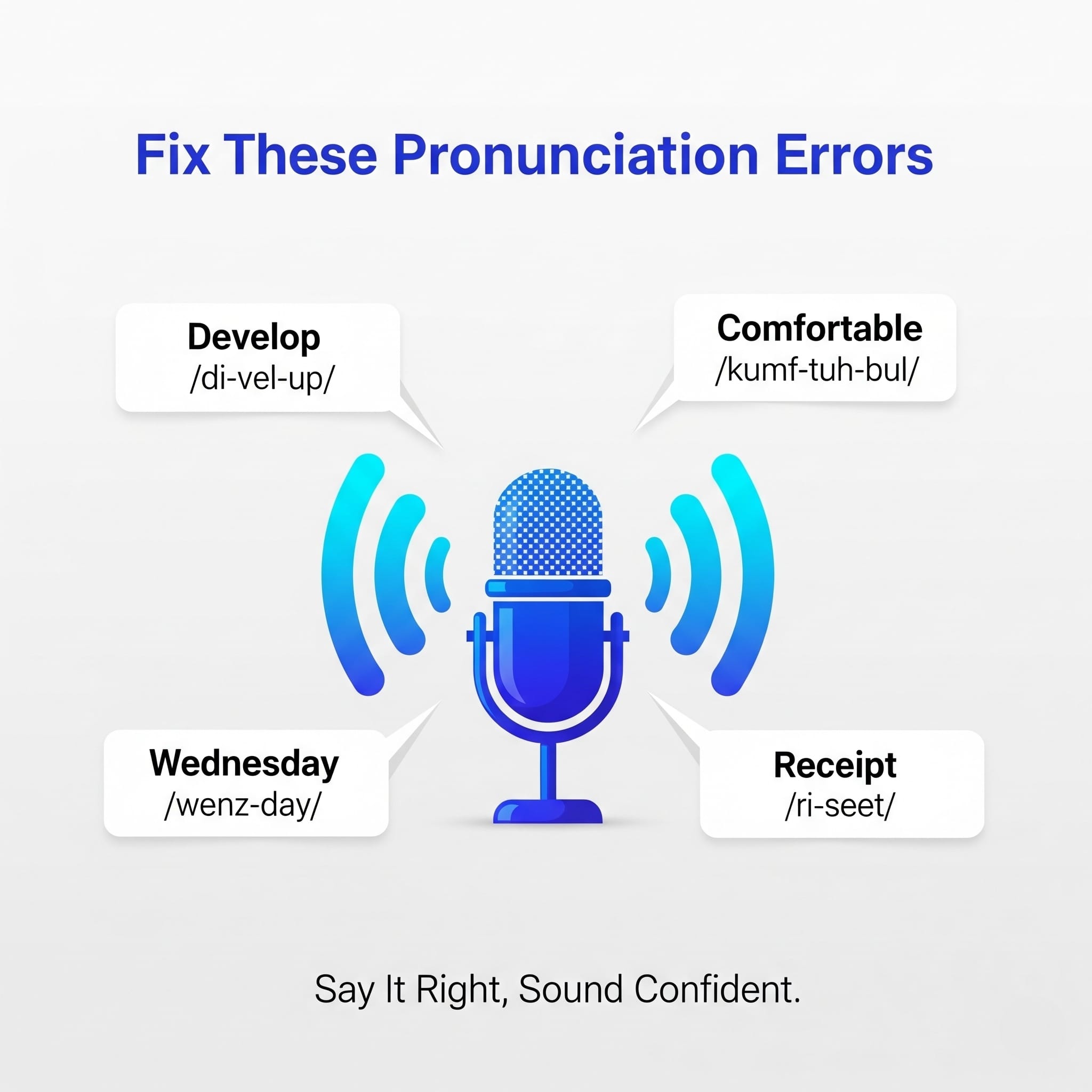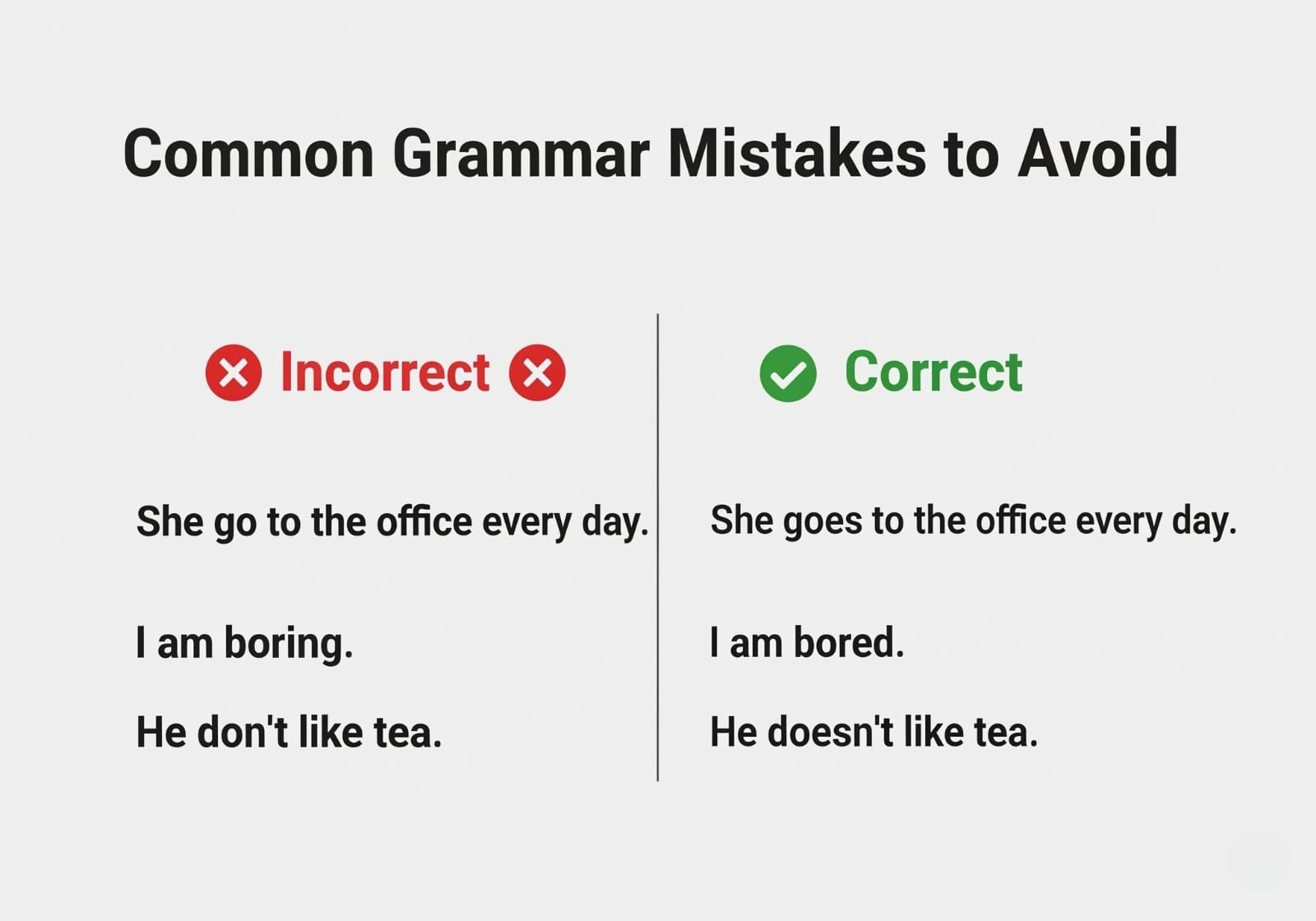40 Things To Avoid While Learning To Speak English
Discover the most common English learning mistakes and how to avoid them. Learn practical tips, grammar corrections, pronunciation tricks, and fluency habits with guidance from Clapingo’s expert tutors.

English Mistakes To Avoid
Why Most Learners Get Stuck
Learning English is not just about memorizing words or studying grammar. Many learners spend months or years learning the language but struggle to communicate fluently. Why? Most learners keep repeating English learning mistakes and common errors that slow progress and reduce confidence.
Mistakes are a natural part of learning, but the problem is repeating them unknowingly. Learners often focus on memorizing vocabulary lists, reading grammar books, or watching videos passively without engaging in real conversations. This leads to a gap between knowledge and practical application.
This blog reveals the top mistakes learners make, why they happen, and how to correct them. Each section includes practical exercises, real-life examples, and tips for improvement, plus insights from Clapingo, which specializes in live, one-on-one English practice.
By the end, you’ll understand how to avoid common errors, learn to speak confidently, and develop a step-by-step roadmap for English fluency. Whether you are a student, professional, or casual learner, these strategies will help you stop repeating errors and start speaking naturally.
Clapingo Tip: Keep a notebook handy to track your errors as you read through this blog. This will make your learning process more intentional and effective.
1. Grammar Mistakes: The Foundation Errors
Grammar is the backbone of any language. Even if you have a strong vocabulary, incorrect grammar can make sentences confusing or misleading. Common errors include subject-verb disagreement, wrong tense usage, missing articles, and misused prepositions.
Examples:
❌ “She go to office every day.” → ✅ “She goes to the office every day.”
❌ “He don’t like tea.” → ✅ “He doesn’t like tea.”
❌ “I have saw the movie.” → ✅ “I have seen the movie.”
Many learners struggle with irregular verbs, article usage, and plural forms because they memorize rules in isolation without applying them in real speech. A simple solution is to practice five sentences daily, focusing on common structures and speaking them aloud.
Clapingo Tip: Tutors provide instant corrections during live sessions, explaining why certain forms are wrong, which reinforces learning.
Exercise: Write five sentences about your daily routine. Record yourself saying them aloud. Compare your speech to correct models and note areas for improvement. Regularly practicing grammar in context dramatically reduces repeated mistakes.
2. Vocabulary Misuse: Words Matter
Many learners struggle with choosing the right word for a given context. Misused vocabulary can make sentences confusing or unintentionally humorous.
Examples:
❌ “I am boring.” → ✅ “I am bored.”
❌ “He is an intelligently boy.” → ✅ “He is an intelligent boy.”
❌ “I have many works.” → ✅ “I have a lot of work.”
Why this happens: Most learners memorize word lists instead of using words in context. Words also have subtle nuances, and a literal translation from your native language often fails.
Solution: Learn vocabulary through sentences, stories, and real conversations, not isolated lists. Practice forming your own sentences and using them in context. Clapingo tutors help learners by correcting misuse instantly and providing alternative word choices.
Practical Tip: Keep a daily vocabulary journal. Write five new words and create sentences. Speak these sentences aloud to reinforce memory and pronunciation. Over time, this builds both fluency and accuracy.
Example Dialogue:
Student: “I am boring.”
Tutor: “Do you mean you feel bored?”
Student: “Yes, I am bored.”

Pronunciation Mistakes In English
3. Pronunciation Problems: Speak Clearly
Even with perfect grammar and vocabulary, poor pronunciation can make it difficult for others to understand you. Mispronounced words can lead to confusion or unintended meanings.
Examples:
“Desert” (place) vs. “Dessert” (sweet)
“Live” (verb) vs. “Live” (adjective for broadcast)
“Comfortable” → /ˈkʌmf.tə.bəl/
“Wednesday” → /ˈwenz.deɪ/
Why learners struggle: English has irregular pronunciation rules and silent letters. Translating words phonetically from your native language is often inaccurate.
Solution:
Record yourself reading aloud
Repeat after native speakers
Practice shadowing exercises where you mimic a sentence exactly as spoken
Use Clapingo sessions for real-time pronunciation correction
Practical Tip: Focus on tricky consonants, vowel sounds, and stress patterns. Record your voice and compare it to a tutor or native speaker. Consistent practice makes pronunciation more natural over time.
Exercise: Pick five difficult words each day. Record your pronunciation and repeat until accurate.
4. Over-Translating from Native Language
Many learners think in their native language and translate word-for-word into English. This often results in awkward or incorrect sentences.
Example:
❌ “I am going to do one thing, I will call you after.
✅ “I’ll call you later.”
Why it happens: Translating slows down your thought process and creates sentence structures that sound unnatural in English.
Solution: Learn common phrases and sentence patterns instead of translating. Think in English as early as possible.
Tip: Practice mini-dialogues daily. Use Clapingo’s roleplay exercises to simulate real-life conversations, helping your brain switch to English naturally.
Exercise: Describe your morning routine aloud in English without translating. Correct yourself using a tutor or recording playback.
5. Hesitation and Filler Words
Using fillers like “um,” “like,” or “you know” is a common fluency trap. Excessive hesitation makes you sound unsure and reduces credibility.
Why it happens: Learners are thinking of the next word or grammar structure instead of focusing on communication.
Solution:
Replace fillers with short pauses
Practice speaking in 2–3 sentence chunks
Use Clapingo’s timed speaking drills to reduce hesitation
Exercise: Record yourself speaking about any topic for 1 minute without fillers. Gradually increase the time. You will gain control over natural pauses and smooth flow.
Example:
Before: “I, um, think, like, we should, you know, start the project.”
After: “I think we should start the project.”
6. Tone and Formality Errors
Matching tone and formality to the situation is essential. Using casual expressions in professional settings or overly formal language in casual settings can make conversations awkward.
Examples:
❌ “Hey bro, send me that report.” (workplace)
✅ “Could you please share the report?”
Why it happens: Learners often transfer casual native expressions to English without understanding professional norms.
Solution: Observe email templates, workplace conversations, and video tutorials to understand appropriate tone. Practice with tutors on Clapingo for real-life context.
Clapingo Tip: Create two separate phrase lists; one for formal situations and one for casual conversations. Practice switching between them to develop a natural flow.
Exercise: Write 5 formal emails and 5 casual messages in English. Read them aloud to check tone and clarity.
7. Ignoring Listening Skills
Many learners focus solely on speaking but neglect listening, which is critical for comprehension and fluency. Without active listening, you may misunderstand instructions or fail to respond naturally in conversation.
Why it happens: Learners often prioritize memorization or grammar exercises over engaging with spoken English.
Solution:
Listen to podcasts, news, or conversations daily.
Summarize what you hear aloud to reinforce understanding and speaking.
Use Clapingo listening exercises for guided practice.
Exercise: Pick a 1–2 minute audio clip. Listen carefully, then explain its content in your own words. Compare your explanation with the original to check accuracy.
Clapingo Tip: Listening improves vocabulary, pronunciation, and sentence structure. The more you listen, the faster you think in English naturally.
8. Overusing Complex Words
Trying to sound “smart” with advanced vocabulary often backfires. Complex words can confuse listeners or sound unnatural.
Example:
❌ “I encountered an unforeseen meteorological phenomenon.”
✅ “It suddenly started raining.”
Why it happens: Learners memorize advanced words without understanding proper context.
Solution: Prioritize clarity over complexity. Use simple words correctly, then gradually include advanced vocabulary naturally.
Exercise: Rewrite five complex sentences into simple, natural ones. Speak them aloud to practice fluency.
Clapingo Tip: Tutors guide learners on when and how to use complex words appropriately, ensuring natural flow in conversations.
9. Memorizing Without Practice
Memorizing words, phrases, or grammar rules without applying them in conversation is ineffective. Knowledge without practice does not create fluency.
Why it happens: Learners believe memorization equals mastery, but constructing sentences in real time is key.
Solution: Apply memorized phrases in daily conversations, roleplays, or speaking exercises.
Exercise: Pick five memorized phrases daily. Use each in three different scenarios: casual chat, workplace, or presentation.
Clapingo Tip: Tutors provide real-time prompts and corrections, helping you transfer memorized knowledge into practical usage.
Tip: Short, consistent speaking practice beats hours of passive memorization.
10. Ignoring Intonation
English is a stress-timed language; flat speech sounds robotic. Intonation changes meaning and conveys emotion.
Example:
“You did it?” → surprise
“You did it?” → accusation
Solution: Shadow native speakers to internalize stress and melody. Record yourself reading aloud and compare with correct intonation.
Exercise: Read a paragraph aloud, focusing on rising and falling tones. Record and review with a tutor.
Clapingo Tip: Tutors guide learners on sentence melody and stress, improving naturalness and clarity.
Tip: Emphasize keywords rather than stressing every word equally.
11. Overthinking Grammar While Speaking
Focusing excessively on grammar during speech breaks fluency. Learners pause mid-sentence, self-correct constantly, and sound unnatural.
Solution: Prioritize communication over perfection. Speak freely, then review mistakes afterward.
Exercise: Talk for 2 minutes on any topic without correcting yourself. Later, analyze errors in a journal.
Clapingo Tip: Tutors highlight patterns in mistakes and provide strategies to reduce overthinking.
Tip: Confidence grows faster than perfect grammar. Accept mistakes as part of learning.
12. Lack of Feedback
Without feedback, errors become habits. Learners often assume correct usage without verification.
Solution: Seek regular feedback through tutors, peers, or recorded reviews.
Clapingo Tip: Tutors provide instant corrections and explain why sentences are wrong, accelerating fluency.
Exercise: Record two to three sentences daily. Compare with models and note corrections.
Tip: Constructive feedback converts theory into practical ability. Regular review prevents repeated mistakes.
13. Speaking Too Fast
Rushing makes pronunciation unclear, grammar incomplete, and speech hard to follow. Learners often speak fast due to nervousness.
Solution: Slow down. Focus on clarity and natural pauses. Breath control improves fluency.
Exercise: Read paragraphs slowly, then gradually increase speed while maintaining clarity. Record and compare.
Clapingo Tip: Tutors monitor pacing and suggest breathing or pause techniques for fluent delivery.
Tip: Fluency is natural flow, not speed. Prioritize understanding over rushing.
14. Avoiding Real Conversations
Fear of mistakes often prevents learners from speaking. Avoiding conversation stops practical learning.
Solution: Engage in daily conversations with peers, tutors, or language partners. Roleplay real-life scenarios.
ClapingoTip: Tutors provide realistic situations—meetings, interviews, casual chats—to build confidence.
Exercise: Set a daily 5–10 minute English conversation goal. Focus on expressing ideas rather than perfection.
Tip: Mistakes show effort. Each conversation builds fluency and confidence.
15. Native Language Interference
Switching between your native language and English mid-sentence causes errors.
Solution: Create “English-only zones” at home, work, or study sessions. Practice thinking directly in English.
Clapingo Tip: Tutors encourage learners to speak fully in English, correcting interference patterns.
Exercise: Speak for 5 minutes in English only. If stuck, pause and think in English instead of translating.
Tip: Thinking in English becomes natural with consistent practice.
16. Not Reviewing Progress
Without tracking progress, repeated mistakes persist.
Solution: Record weekly speeches and maintain a journal of recurring errors.
Clapingo Tip: Tutors provide progress charts and personalized improvement plans.
Exercise: Record a 1-minute speech weekly on the same topic. Compare and identify improvements and new mistakes.
Tip: Visible progress motivates learners and highlights areas needing attention.
17. Forgetting Idioms and Phrases
Idioms and phrases make speech sound natural. Ignoring them limits fluency.
Examples:
“Break the ice” → start a conversation
“Hit the nail on the head” → be precise
Solution: Learn idioms in context. Practice using them in sentences.
Clapingo Tip: Tutors provide scenarios to use idioms naturally.
Exercise: Use 3 new idioms daily in conversations.
Tip: Flashcards or journals enhance retention and application.
18. Not Using Body Language
Non-verbal cues - gestures, posture, facial expressions—enhance communication.
Solution: Pair words with gestures. Maintain eye contact, smile, and nod naturally.
Clapingo Tip: Tutors observe body language during sessions and suggest improvements.
Exercise: Record a short presentation. Evaluate gestures, posture, and facial expressions.
Tip: Body language conveys confidence even if your words aren’t perfect.
19. Over-Dependency on Apps
Language apps are useful but cannot replace live speaking practice.
Solution: Combine apps with real-time conversations. Practice with Clapingo tutors for guidance and correction.
Exercise: Learn a concept from an app, then speak about it aloud for 5 minutes with a tutor or friend.
Tip: Balance technology and live practice for true fluency.
20. Ignoring Cultural Context
Language is deeply tied to culture. Misunderstanding cultural norms can make English communication awkward or even offensive.
Example:
❌ Using overly direct phrases in formal emails may seem rude.
✅ “Could you please review this report?” sounds polite and professional.
Solution: Learn common cultural practices in English-speaking contexts. Observe greetings, tone, and polite phrasing.
Clapingo Tip: Tutors provide real-life examples from business, casual, and academic contexts, helping learners adapt language naturally.
Exercise: Watch a short English conversation video. Identify formal and informal expressions. Practice using them in roleplays.
Tip: Contextual awareness improves fluency and builds confidence in cross-cultural communication.
21. Singular and Plural Errors
Confusing singular and plural forms is common among learners. Mistakes here disrupt sentence clarity.
Examples:
❌ “I have many book.” → ✅ “I have many books.”
❌ “She is good in maths.” → ✅ “She is good at maths.”
Solution: Learn regular and irregular plural rules. Practice making sentences with countable and uncountable nouns.
Exercise: Take 10 nouns and write 3 sentences for each, alternating singular and plural forms. Speak them aloud.
Clapingo Tip: Tutors highlight frequent mistakes and provide mini-exercises to reinforce correct usage.
Tip: Repetition and application are key to mastering singular/plural forms.
22. Preposition Confusion
Prepositions are tricky because their usage often doesn’t translate directly from other languages.
Examples:
❌ “I am good in English.” → ✅ “I am good at English.”
❌ “She is married with a doctor.” → ✅ “She is married to a doctor.”
Solution: Learn prepositions in phrases and sentences, not in isolation.
Exercise: Write 5 sentences daily using common prepositions (in, on, at, to, with). Speak them aloud.
Clapingo Tip: Tutors provide exercises with instant correction, explaining common errors and alternatives.
Tip: Focus on memorizing prepositions through context rather than isolated rules.
23. Misusing Passive Voice
Overuse or misuse of the passive voice can make sentences unclear or awkward.
Examples:
❌ “The homework is done by me yesterday.” → ✅ “I did the homework yesterday.”
❌ “Mistakes were made by him.” → ✅ “He made mistakes.”
Solution: Use passive voice only when necessary. Focus on active voice for clear communication.
Exercise: Rewrite 5 passive sentences into active form. Practice saying them aloud.
Clapingo Tip: Tutors guide learners on when passive voice is appropriate, ensuring natural usage.
Tip: Active sentences usually sound more direct and fluent.

Common English Grammar Mistakes
24. Tense Mix-Ups
Incorrect tense usage is a common stumbling block for learners. Mixing past, present, and future tenses in one sentence can confuse listeners.
Examples:
❌ “Yesterday I go to the market.” → ✅ “Yesterday I went to the market.”
❌ “I am doing my homework yesterday.” → ✅ “I did my homework yesterday.”
Solution: Practice tenses through daily journaling and storytelling. Focus on one tense at a time.
Exercise: Write five sentences in past, present, and future tenses daily. Speak each aloud.
Clapingo Tip: Tutors correct tense errors instantly and provide targeted exercises for improvement.
Tip: Tense consistency improves clarity and listener comprehension.
25. Ignoring Sentence Stress
Stress patterns in English words and sentences affect meaning. Misplaced stress can confuse listeners.
Examples:
“CONtract” (noun) vs. “conTRACT” (verb)
“I didn’t say she stole the money.” (different stress changes meaning)
Solution: Learn stress patterns in words and sentences. Practice shadowing native speakers.
Exercise: Take 5 new words daily. Mark stressed syllables and speak them aloud. Record and compare with native pronunciation.
Clapingo Tip: Tutors provide pronunciation exercises highlighting stressed syllables in real-time.
Tip: Sentence stress adds natural rhythm and fluency to speech.
26. Not Keeping a Mistake Journal
Failing to track errors prevents targeted improvement. A mistake journal is a simple yet powerful tool.
Solution: Note every new mistake you make, along with the correction and explanation. Review daily or weekly.
Exercise: Keep a 5-column table: Date, Mistake, Correct Sentence, Explanation, Practice Example. Speak examples aloud.
Clapingo Tip: Tutors encourage learners to maintain mistake journals and review them during sessions.
Tip: Recording and reflecting on mistakes accelerates fluency.
27. Neglecting Small Talk
Small talk is essential for social and workplace conversations. Ignoring it can make interactions stiff.
Solution: Practice casual topics like weather, hobbies, or recent events. Use Clapingo roleplay exercises for conversation practice.
Exercise: Prepare 3 questions and 3 answers for small talk daily. Speak them with a partner or tutor.
Tip: Small talk builds confidence and helps develop natural conversation flow.
28. Not Reading Aloud
Silent reading does not train speaking skills effectively. Reading aloud improves pronunciation, intonation, and fluency.
Exercise: Read a paragraph aloud every day. Record yourself and compare with a tutor or native speaker.
Clapingo Tip: Tutors provide live reading exercises and correct pronunciation mistakes in real time.
Tip: Reading aloud also helps internalize sentence structures and vocabulary usage.
29. Giving Up Too Soon
Learning English is a marathon, not a sprint. Many learners quit after a few weeks due to frustration.
Solution: Set small, achievable goals. Celebrate incremental progress.
Clapingo Tip: Tutors provide structured goals and progress tracking to motivate learners.
Exercise: Commit to speaking 5–10 minutes daily for one week. Track improvements.
Tip: Persistence beats perfection. Mistakes are milestones in the learning journey.
30. Ignoring Storytelling Practice
Storytelling enhances fluency, vocabulary, and sentence construction. Ignoring it limits expressive skills.
Exercise: Retell a short story or personal experience daily. Focus on sequence and details.
Clapingo Tip: Tutors guide learners in organizing thoughts, using connectors, and applying idioms in storytelling.
Tip: Storytelling builds confidence and engages listeners.
31. Listening vs. Speaking Balance
Many learners focus heavily on either listening or speaking, neglecting the other. This creates an imbalance—good comprehension but poor expression, or fluent speech with misunderstandings.
Solution: Maintain a balance. Spend time listening daily and then speaking what you’ve understood.
Exercise: Listen to a short audio clip (1–2 minutes), summarize it aloud, and discuss with a tutor or partner. Repeat daily.
Clapingo Tip: Tutors guide learners to integrate listening with speaking through real-time exercises.
Tip: Alternating between listening and speaking ensures vocabulary, grammar, and pronunciation improve together.
32. Ignoring Synonyms and Paraphrasing
Relying on the same words repeatedly makes speech monotonous. Knowing synonyms improves fluency and versatility.
Example: Instead of always saying “good,” use “excellent,” “great,” or “fantastic” depending on context.
Exercise: Pick five common words each day and find three synonyms. Use them in sentences and speak aloud.
Clapingo Tip: Tutors suggest alternative phrases in context, ensuring natural usage in both casual and professional settings.
Tip: Paraphrasing helps avoid repetition, making conversations engaging and fluent.
33. Shadowing Practice
Shadowing involves listening and repeating simultaneously, mimicking native speakers’ rhythm, intonation, and stress. Ignoring this limits natural fluency.
Exercise: Select a short audio or video clip. Play it line by line, repeating immediately after the speaker, matching tone and speed.
Clapingo Tip: Tutors provide live shadowing exercises and give feedback on pronunciation, stress, and intonation.
Tip: Shadowing accelerates thinking in English and improves speaking confidence.
34. Active Vocabulary Building
Passive memorization is ineffective. Active vocabulary use in writing and speaking is essential for retention.
Exercise: Write 5 new words daily, create sentences, and speak them aloud. Apply them in conversations or roleplays.
Clapingo Tip: Tutors suggest real-life scenarios for practicing new words and provide instant corrections.
Tip: Daily active vocabulary building ensures words are not just known but naturally used.
35. Handling Interruptions
Interruptions can disrupt fluency and confidence. Many learners lose focus mid-sentence or hesitate under pressure.
Solution: Practice pausing strategically and restarting sentences confidently. Use filler phrases like “Let me continue” or “As I was saying.”
Exercise: Roleplay conversations with simulated interruptions. Record yourself managing smoothly.
Clapingo Tip: Tutors provide real-life scenarios to train learners in maintaining fluency despite interruptions.
Tip: Handling interruptions gracefully reflects confidence and command over language.
36. Reading Varied Content
Sticking to one type of material (e.g., textbooks) limits exposure to natural English. Reading news, blogs, fiction, and dialogues improves vocabulary and context understanding.
Exercise: Read a news article, a short story, and a dialogue daily. Note new phrases and practice speaking them aloud.
Clapingo Tip: Tutors suggest varied content and create discussion prompts to practice comprehension and expression.
Tip: Exposure to diverse content prepares learners for different conversation contexts.
37. Not Asking Questions
Avoiding questions in conversation leads to one-sided dialogue and missed learning opportunities. Asking questions helps clarify understanding and build interaction skills.
Exercise: Prepare 3 questions on a topic before any conversation. Ask them and respond naturally.
Clapingo Tip: Tutors encourage learners to ask questions during sessions, improving spontaneity and confidence.
Tip: Questions drive conversation flow and reveal subtle language patterns.
38. Avoiding Self-Correction
Ignoring mistakes prevents improvement. Self-correction after speaking strengthens understanding and prevents repeating errors.
Exercise: Speak on a topic for 2 minutes. Replay or review with a tutor, noting mistakes and correcting them aloud.
Clapingo Tip: Tutors guide learners on identifying recurring errors and practicing corrections.
Tip: Self-correction builds independence and accelerates fluency.
39. Underusing Technology
While technology aids learning, underuse of tools like pronunciation apps, recording devices, and speech analyzers limits progress.
Exercise: Record your voice daily, analyze pronunciation or sentence flow, and practice weak points.
Clapingo Tip: Tutors integrate tech tools during sessions to track errors and provide targeted exercises.
Tip: Using technology complements live speaking practice for measurable improvement.
40. Not Setting Measurable Goals
Learning without goals leads to unstructured practice and frustration. Measurable goals keep progress on track.
Exercise: Set weekly targets like “Use 10 new words in conversation” or “Speak fluently for 5 minutes daily.” Track completion.
Clapingo Tip: Tutors help set realistic goals and monitor progress during sessions.
Tip: Measurable goals provide motivation, clarity, and focus for consistent improvement.
Clapingo Spotlight
Clapingo offers live, personalized English practice for learners worldwide. Tutors provide real-time corrections, structured exercises, and speaking opportunities.
Benefits:
Immediate feedback on grammar, pronunciation, and vocabulary
Real-life conversation simulations
Progress tracking with actionable insights
Tip: Combine Clapingo sessions with daily practice to maximize fluency.
Did You Know?
Did you know that over 70% of English learners struggle with speaking due to fear of mistakes, not lack of knowledge?
Active practice, feedback, and structured correction are more effective than memorization alone. Tools like Clapingo accelerate fluency by combining knowledge with application.
Clapingo Tip: Engage in at least 10–15 minutes of speaking daily. Mistakes are proof of learning progress.

Quick Fixes for English Mistakes
Tips & Tricks
Speak daily, even for 5 minutes
Shadow native speakers
Keep a mistake journal
Use idioms and varied vocabulary
Record and review your speech
Clapingo Tip: Tutors provide personalized tips tailored to your learning style.
Real-Life Dialogues
Practicing dialogues enhances practical fluency. Examples:
Work: “Could you please send me the report by EOD?”
Casual: “Hey, how was your weekend?”
Interview: “Can you describe a challenging project you managed?”
Exercise: Roleplay these with a tutor or partner daily.
Clapingo Tip: Practicing realistic conversations prepares learners for any situation.
Common Indian Learner Mistakes
Indian learners often:
Mix tenses unnecessarily
Use literal translations from native language
Overuse “is” or “the”
Solution: Focus on sentence patterns, context-based learning, and regular practice.
Clapingo Tip: Tutors provide tailored exercises to overcome common mistakes.
Mindset Shift
Fluency requires confidence and a growth mindset. Avoid fearing mistakes; see them as learning steps.
Exercise: Affirm daily: “Mistakes help me improve. I will speak confidently today.”
Clapingo Tip: Positive mindset boosts willingness to speak and experiment with language.
Motivation Corner
Motivation sustains consistency. Reward small wins and track progress visually.
Exercise: Create a progress chart marking hours practiced, phrases learned, and dialogues attempted.
Clapingo Tip: Celebrate small achievements to maintain enthusiasm for learning English.
One Rule Per Day Habit
Focus on one language habit daily. For example:
Day 1: Correct use of articles
Day 2: Pronunciation practice
Day 3: Shadowing sentences
Exercise: Pick one rule, practice it in writing and speaking, review at the end of the day.
Clapingo Tip: Tutors reinforce these habits during sessions, providing corrections and examples.
Tip: Small daily habits lead to consistent fluency over time.
Clapingo Spotlight
Learning English requires more than self-study—it demands live interaction, instant feedback, and structured practice. That’s where Clapingo comes in.
Why Clapingo Works:
Personalized Tutoring: One-on-one sessions tailored to your level, focusing on grammar, vocabulary, pronunciation, and fluency.
Real-Life Practice: Engage in conversations simulating workplace meetings, interviews, casual chats, and storytelling.
Instant Corrections: Tutors provide immediate feedback, correcting mistakes in real time and explaining why they occurred.
Progress Tracking: Each session records your performance, highlighting areas for improvement and helping set achievable goals.
Convenience: Practice anytime, anywhere, ensuring consistent learning without disrupting your schedule.
Exercise Example:
Pick a topic like “My Weekend Plans.” Speak for 2–3 minutes with a Clapingo tutor. Focus on grammar, pronunciation, and natural sentence flow. Your tutor will highlight errors, suggest improvements, and help you rephrase sentences more naturally.
Tip: Combine Clapingo sessions with daily self-practice. Even 10–15 minutes of speaking with guidance accelerates fluency.

Clapingo English Conversations
Conclusion
Avoiding common English learning mistakes is essential for fluency, confidence, and effective communication. Mistakes in grammar, pronunciation, vocabulary, or cultural context are normal but repeating them can slow progress.
Key Takeaways:
Focus on active practice, not just memorization.
Balance listening and speaking daily.
Track errors with a mistake journal.
Practice real-life dialogues and roleplays.
Seek feedback regularly to correct recurring mistakes.
Remember, fluency develops gradually. Each mistake is a learning opportunity, and consistent practice leads to noticeable improvement. Platforms like Clapingo bridge the gap between theory and real-world usage, offering personalized guidance and confidence-building exercises.
Start today by identifying your key mistakes, practicing deliberately, and speaking boldly. With patience, persistence, and the right support, mastering English is entirely achievable.
Read Also: 20 Reasons Why Your English Isn’t Improving (And How to Fix It)
Comments
Your comment has been submitted successfully!